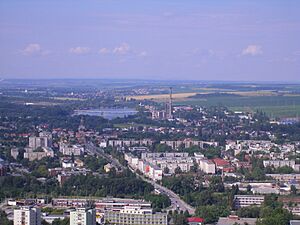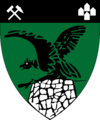Tatabánya facts for kids
Quick facts for kids
Tatabánya
|
|||
|---|---|---|---|
|
City with county rights
|
|||

Tatabánya in June 2008
|
|||
|
|||
| Lua error in Module:Location_map at line 416: Malformed coordinates value. | |||
| Country | |||
| Region | Central Transdanubia | ||
| County | Komárom-Esztergom | ||
| District | Tatabánya | ||
| Area | |||
| • Total | 91.42 km2 (35.30 sq mi) | ||
| Elevation | 167 m (548 ft) | ||
| Population
(2022)
|
|||
| • Total | 64,305 | ||
| • Rank | 12th | ||
| Area code(s) | 34 | ||
| Motorways | M1 | ||
| Distance from Budapest | 60.1 km (37.3 mi) East | ||
Tatabánya is a city in northwestern Hungary. It has about 64,305 people living there (as of 2022). It is the main city of Komárom-Esztergom County. Tatabánya is known as a "city with county rights." This means it has special powers, similar to a county itself.
Contents
Location and Transport
Tatabánya is found in a valley between the Gerecse and Vértes Mountains. It is about 55 kilometers (34 miles) from Budapest, the capital city. Because of where it is located, Tatabánya is an important place for both trains and roads. The M1 highway, which connects Vienna to Budapest, goes past the city. The main railway line between Vienna and Budapest also runs through Tatabánya.
History of Tatabánya
People have lived in the area around Tatabánya for a very long time. Archaeologists have found proof that humans were here even in the Stone Age. The city we know today was formed from three older villages: Alsógalla, Felsőgalla, and Bánhida. Bánhida is the oldest of these, first mentioned way back in 1288.
In the 1500s, the Ottoman Turks took control of this region. During this time, many local people became Protestants. Later, the powerful Esterházy family, who owned the land, brought in new settlers. These new residents were Roman Catholic Germans and Slovaks.
A count from 1787 showed that Alsógalla had 580 people and Felsőgalla had 842. Around this time, people discovered that there was a lot of coal in the area. This discovery led to more people moving there. A new mining community grew, which later became the village of Tatabánya.
After World War II, Hungary went through a big change called industrialization. Many towns grew into large industrial cities. On October 1, 1947, the four villages (Alsógalla, Felsőgalla, Bánhida, and Tatabánya) were joined together. They were all given the name Tatabánya and became a town. In 1950, Tatabánya became the capital of Komárom-Esztergom county. By the 1980s, the city had more than 80,000 residents.
Tatabánya was a very industrial city until the government changed in 1989. After that, the importance of heavy industry and mining went down. The city's economy then started to change a lot.
Infrastructure and Services
In 2001, a survey showed that Tatabánya had 28,912 homes. Most of these homes (92%) had central heating and phones. Almost all homes also had access to cable TV. About 98% of the city's roads are paved. Public transport is well organized. T-Busz runs local bus services, and KNYKK handles regional bus services.
Education in Tatabánya
In the middle of the 20th century, education in Tatabánya was about average. However, it got worse in the second half of the century. This was mainly because the local mines did not need workers with a high level of education. By the end of the 20th century, this trend changed. Education standards improved again. Today, Tatabánya has two colleges and ten high schools. It also has 16 primary schools, 18 kindergartens, and five nurseries for very young children.
Culture and Sports
The most important cultural place in Tatabánya is the Mari Jászai Theatre. The city also has other cultural spots, like museums and libraries.
Tatabánya has a football (soccer) team called FC Tatabánya, which started in 1910. The city also has a very good handball team, Tatabánya KC.
One of the most famous people from Tatabánya is József Kiprich. He was known as "the Wizard from Tatabánya." In 1985, he became the top goal scorer in the Hungarian League. He scored 18 goals in 26 games that year. He played for Tatabánya for nine seasons. After that, he moved to the Netherlands to play for Feyenoord in Rotterdam. Kiprich is also one of Hungary's best goal scorers for the national team. He scored 28 goals in 70 games over eleven seasons.
City Sights
The Turul monument is a huge statue located above the city. It sits on top of Gerecse Mountain. This statue is the largest bird statue in Central Europe.
The Szelim cave is another popular spot. The forest park of Gerecse Mountain is also a great place for tourists to visit.
City Districts
Tatabánya is divided into eight main parts, called districts:
- Alsógalla
- Sárberek
- Újváros
- Bánhida
- Kertváros
- Dózsakert
- Felsőgalla
- Óváros
Nearby Villages
Here are some villages close to Tatabánya:
- Gyermely
- Héreg
- Környe
- Szárliget
- Szomor
- Tarján
- Tardos
- Várgesztes
- Vértessomló
- Vértesszőlős
Notable People
- Éva Csernoviczki (born 1986), judoka
- Rita Deli (born 1972), handball player
- András Dombai (born 1979), footballer
- Bernadett Ferling (born 1977), handball player
- Ádám Gyurcsó (born 1991), football winger
- Anita Herr (born 1987), handball player
- Orsolya Herr (born 1984), handball player
- Viktor Kassai (born 1975), football referee
- Andrea Keszler (born 1989), short-track speed-skater
- Klára Killermann (1929-2012), breaststroke swimmer
- József Kiprich (born 1963), football striker
- Béla Kovács (born 1937), clarinetist
- László Kovács (born 1951), football goalkeeper
- Zsolt Kunyik (born 1974), judoka
- Csaba Kuzma (born 1954), light-heavyweight boxer
- Ferenc Machos (1934-2006), footballer
- Viktória Pácz (born 1990), handball player
- Josef Papp (1933-1989), American engineer
- Csaba Schmidt (born 1979), chemist and politician, mayor of Tatabánya
- Szandra Szalay (born 1989), triathlete
- Patricia Szölösi (born 1991), handballer
- László Szűcs (born 1991), footballer
- István Vincze (born 1967), footballer
- Miklós Fehér (1979-2004) footballer
Sister Cities
Tatabánya has "sister city" relationships with other cities around the world. This means they share culture and friendship.
 Aalen, Germany (since 1987)
Aalen, Germany (since 1987) Banská Štiavnica, Slovakia (since 2017)
Banská Štiavnica, Slovakia (since 2017) Będzin, Poland (since 2000)
Będzin, Poland (since 2000) Christchurch, United Kingdom (since 1992)
Christchurch, United Kingdom (since 1992) Fairfield, United States (since 1993)
Fairfield, United States (since 1993) Odorheiu Secuiesc, Romania (since 2000)
Odorheiu Secuiesc, Romania (since 2000) Izhevsk, Russia (since 1992)
Izhevsk, Russia (since 1992)
Town Partnerships
Tatabánya also has partnerships with these towns:
 Arad, Romania
Arad, Romania Hoogezand-Sappemeer, Netherlands
Hoogezand-Sappemeer, Netherlands Nové Zámky, Slovakia
Nové Zámky, Slovakia Saint-Ghislain, Belgium
Saint-Ghislain, Belgium Saint-Lô, France
Saint-Lô, France
Gallery
See also
 In Spanish: Tatabánya para niños
In Spanish: Tatabánya para niños











